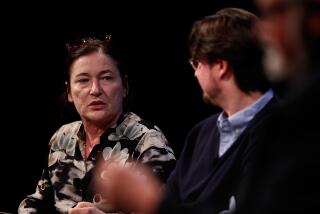‘Reborn: Journals & Notebooks 1947-1963’ by Susan Sontag, edited by David Rieff
Reborn
Journals & Notebooks
1947-1963
Susan Sontag,
edited by David Rieff
Farrar, Straus & Giroux:
318 pp., $25
In September 2006, an excerpt of Susan Sontag’s diaries, edited by her son, David Rieff, was published in the New York Times magazine, and that night I went to a dinner party where a woman poet in her 50s exhaled a sigh of disgust. Sontag is shown in her 20s, cutting a swath through literary hedges in Paris and New York and reeling from heartbreaking affairs with women. The poet’s hands were balled into fists behind a wedge of cheesecake: “The point is to feed tabloid hunger -- expose Sontag as a lesbian and mindlessly ambitious.”
The poet was huffy because Sontag’s private life was being revealed at all and because the disclosures included striving and queerness. She was trying to protect Sontag from herself, which is what Sontag mostly tried to do by keeping buttoned up about her personal affairs. In her essays and fiction, she depicted sexual longing as an untamable force, trailing the twist and tang of bliss and self-destruction, but she did not write about how she lived in her body. She wrote a book about illness without discussing her own experience of cancer, and she meditated on homosexuality without speculating on how being gay had shaped her life. In veiling both the sexual body and the ill body, she generated something of an eros of concealment.
But how did she feel about these issues as society was becoming less phobic about them -- partly due to her advocacy? She sold her papers to UCLA, knowing they would be published, and her son, believing himself her most sympathetic interpreter, is editing her diaries; the first volume of three is just out. “You know where the diaries are,” she whispered to him near death, he writes in his brief introduction, adding that “my mother loved diaries and letters -- the more intimate the better . . . so perhaps Susan Sontag the writer would have approved of what I’ve done.”
“Reborn,” as Rieff has titled the book, is what Sontag says she felt when, at 16 and a freshman at UC Berkeley, she entered into her first sexual relationship with a young woman. Sex is the theme of this volume, showing the way it illuminates life for a brilliant young thinker who is uncomfortable in her flesh and how it becomes a measure for her thereafter of personal and artistic freedom.
Don’t expect a literary document such as Virginia Woolf’s diary or the letters of Robert Lowell and Elizabeth Bishop. Sontag isn’t practicing being a writer here.
She makes judgments. She summarizes and analyzes rather than showing us people in action, including herself. I feel, I want, she cries, flying from one fever to the next, but how her girlfriends -- principally Harriet Sohmers and Maria Irene Fornes -- look, move and speak when they complain that she is mopey and possessive we don’t learn.
Sontag, shown from age 14 to 30, uses her diary as a containment device for anxiety, anxiety being the default setting of the Homo sapien brain -- the furrowed monkey brow of our inner loops. In the museum of any life, though, sewage can be fascinating too. Sontag can’t come clean about herself to most people, but she tries to be honest with herself, and the strength and poignancy of these pages arise from that effort.
We see her doubting and speculative and, most revelatory, taking on the issue of her wariness. In an incisive entry, written when she is 26, she feels her sexuality can harm her ambition and sees being a writer as a boost to her status: “My desire to write is connected with my homosexuality. I need the identity [of the writer] as a weapon, to match the weapon that society has against me. It doesn’t justify my homosexuality. But it would give me -- I feel -- a license. I am just becoming aware of how guilty I feel being queer. With H. I thought it didn’t bother me, but I was lying to myself. . . . Being queer makes me feel more vulnerable.”
Queerness feels to her like being stupid -- left out and pitiable -- and so she aspires to be a writer with mandarin self-assurance and personal mystery as a hedge against being trivialized.
Throughout her life, though, she also worried about the toll of this reserve on her artistic expressiveness, and in the diary she grapples with this double bind. She knows that to be free means not translating or apologizing for yourself. The kinds of artists she admires -- Kafka is her god -- derive power as social outsiders rather than as arbiters of taste. She just can’t bring herself to take those risks, and so she invents a term -- “X” -- for the bad faith of choosing a protected life: “ ‘X’ is when you . . . want to please and impress people, either by saying what they want to hear, or by shocking them, or by boasting and name dropping or by being very cool.”
Could she ever link her sense of vulnerability to the fragilities of others and in this identification simply look at life without weighing things, as she yearned to do? Some would say she didn’t achieve this in her writing or public persona, but with the publication of her diaries, albeit posthumously, a curtain lifts on what was rickety, nutty and pulsing in the girl she had been and in some ways remained.
Consenting to being seen isn’t the same as setting free the unknowing parts of yourself that are required to make art, but Sontag was shedding a layer of protection by standing with women who present themselves as factories of desire -- for sex, notoriety, greatness, pettiness . . . anything that can be imagined.
In the history of human freedom, a long chapter belongs to looking and exposing, and the publication of women’s diaries is part of this spectacle. Although Sontag seldom framed her life within the general condition of women, she still was one.
And when female desire enters the public space, it lifts the lid on policed expression in general, including the public contemplation of male bodies. Once the vulnerability of the male body (the size and comeliness of various parts, for example) is introduced for evaluation, nothing is protected.
In one of Sontag’s diary entries, she urges just such antic freedom resulting from the blurring of private and public acts: “One of the main (social) functions of a journal or diary is precisely to be read furtively by other people, the people (like parents + lovers) about whom one has been cruelly honest only in the journal.”
Stone is the author of “Starting With Serge,” “Close to the Bone” and “Laughing in the Dark.”
More to Read
The biggest entertainment stories
Get our big stories about Hollywood, film, television, music, arts, culture and more right in your inbox as soon as they publish.
You may occasionally receive promotional content from the Los Angeles Times.






